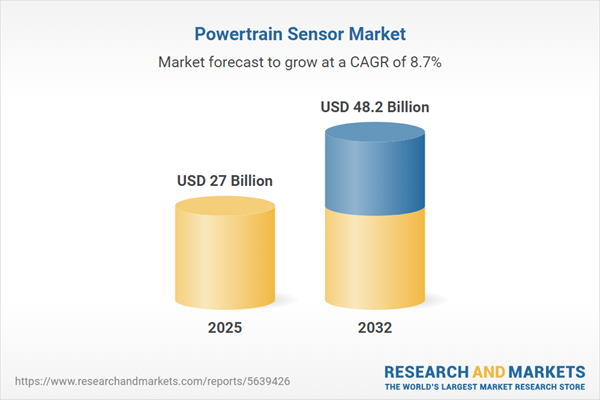Speak directly to the analyst to clarify any post sales queries you may have.
Senior automotive executives face rising complexity in the powertrain sensor market, where technology evolution, regulatory demands, and digital transformation challenge existing frameworks. Navigating this environment requires agile strategic planning and resilient supply chain models.
Market Snapshot: Powertrain Sensor Market
The global powertrain sensor market is projected to increase from USD 24.81 billion in 2024 to USD 27 billion in 2025, achieving a compound annual growth rate (CAGR) of 8.65%. By 2032, the market value is expected to reach USD 48.20 billion. This growth is driven by sustained investment in sensor innovation and widespread integration across commercial fleets, electric vehicles, and emerging semi-autonomous models. Market dynamics are heavily influenced by the push toward increased automation, the adoption of advanced digital vehicle architectures, and ongoing updates to regulatory standards. To keep pace, industry leaders focus on predictive maintenance and robust operational monitoring, ensuring compliance and efficiency. OEMs and suppliers are re-evaluating integration strategies to better meet customer requirements and accommodate evolving global compliance landscapes.
Scope & Segmentation of the Powertrain Sensor Market
- Sensor Types: Flow sensors promote accurate fluid management and operational continuity. Position sensors provide precise engine calibration and monitor the placement of critical components. Pressure sensors play a crucial role in overseeing transmission systems and managing energy flow. Speed sensors are integral for consistent gear changes and responsiveness, while temperature sensors protect powertrain systems from overheating, supporting long-term performance.
- Vehicle Types: Commercial vehicles adopt comprehensive sensor packages to enable direct diagnostics and facilitate predictive maintenance, optimizing costs for large-scale fleets. Passenger vehicles benefit from sensor integration that enables advanced driver assistance capabilities and ensures compliance with emissions requirements, allowing flexible deployment across multiple automotive platforms.
- Sales Channels: Aftermarket providers focus on sensor compatibility and precise calibration during service upgrades, addressing varied maintenance needs. OEM channels prioritize integrated solutions and end-to-end regulatory compliance, enabling accurate performance monitoring for diverse vehicle models.
- Geographic Regions: North America’s market strength lies in robust supply chains and advanced manufacturing ecosystems. Opportunities in Latin America stem from region-specific adaptation for fleet and climate variability. EMEA excels in sensor innovation and agile response to new standards. Asia-Pacific countries—including China, India, Japan, and South Korea—lead in rapid manufacturing and swift technological adoption, helping OEMs capitalize on fast-shifting market trends.
- Leading Companies: Robert Bosch GmbH, DENSO Corporation, Continental AG, BorgWarner Inc., Infineon Technologies AG, TE Connectivity Ltd., Sensata Technologies Holding plc, Honeywell International Inc., Texas Instruments Incorporated, and STMicroelectronics N.V. collectively drive product evolution, system refinement, and partnership optimization within powertrain sensor ecosystems.
Key Takeaways for Senior Decision-Makers
- Miniaturized sensor architectures are advancing lightweight vehicle platforms, enhancing operational efficiency while meeting sustainability goals.
- Integration of analytics-based sensor networks strengthens predictive maintenance, enabling more efficient diagnostics and reducing both downtime and operational risk.
- Real-time powertrain sensor monitoring accelerates fault identification, streamlining service processes and maximizing fleet and passenger vehicle utilization.
- Adaptive sensor configurations enable manufacturers to proactively address regulatory and compliance changes across regional markets, ensuring ongoing operational readiness.
- Cross-sector collaboration between sensor suppliers, semiconductor fabricators, and automotive software partners is critical to enhancing diagnostic precision and supply chain flexibility during market disruptions.
Tariff Impact: Navigating 2025 U.S. Tariffs on Sensor Supply Chains
The 2025 U.S. tariffs on imported sensors prompt automotive leaders to reassess core sourcing strategies and strengthen risk management. Firms are increasingly exploring nearshoring opportunities and forging strategic trade partnerships in markets with favorable trade conditions. Pursuing modular sensor platforms and advancing vertical integration supports resilience, safeguarding technology assets and reducing exposure to evolving trade environments.
Methodology & Data Sources
This report builds on direct engagement with engineering teams at automotive OEMs, suppliers, and regulatory authorities. Comprehensive secondary research—covering industry white papers, patent records, and regulatory filings—underpins all recommendations and informs strategic options for senior stakeholders.
Why This Report Matters
- Enables executive teams to anticipate market shifts in powertrain sensor technology and regulatory frameworks for better risk and compliance management.
- Delivers actionable segmentation by sensor type, vehicle class, channel, and region to guide positioning and optimize supply chain design.
- Supports leaders in building durable supply strategies, ensuring preparedness for regulatory and market-driven disruptions.
Conclusion
By leveraging timely intelligence on emerging market drivers, senior decision-makers can confidently guide strategic transformation and sustain competitive advantage in a rapidly evolving powertrain sensor landscape.
Additional Product Information:
- Purchase of this report includes 1 year online access with quarterly updates.
- This report can be updated on request. Please contact our Customer Experience team using the Ask a Question widget on our website.
Table of Contents
3. Executive Summary
4. Market Overview
7. Cumulative Impact of Artificial Intelligence 2025
Companies Mentioned
The companies profiled in this Powertrain Sensor market report include:- Robert Bosch GmbH
- DENSO Corporation
- Continental AG
- BorgWarner Inc.
- Infineon Technologies AG
- TE Connectivity Ltd.
- Sensata Technologies Holding plc
- Honeywell International Inc.
- Texas Instruments Incorporated
- STMicroelectronics N.V.
Table Information
| Report Attribute | Details |
|---|---|
| No. of Pages | 185 |
| Published | October 2025 |
| Forecast Period | 2025 - 2032 |
| Estimated Market Value ( USD | $ 27 Billion |
| Forecasted Market Value ( USD | $ 48.2 Billion |
| Compound Annual Growth Rate | 8.6% |
| Regions Covered | Global |
| No. of Companies Mentioned | 11 |









